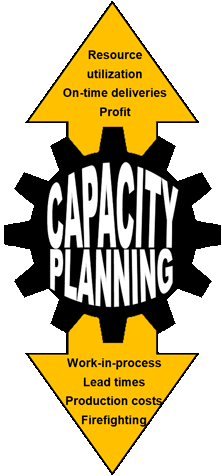Capacity Planning Is Key to a Better Bottom Line
If you use routings, read on! And if you don’t, maybe it’s time to start questioning why not. Operational routings are a source of performance measurements as well as labor and machine requirements, critical components to manufacturing at the lowest cost and in the fastest time.
 Routings, along with the backlog of open and planned orders, is the basis of capacity planning -- a tool that can provide many benefits, including:
Routings, along with the backlog of open and planned orders, is the basis of capacity planning -- a tool that can provide many benefits, including:
- Improved resource utilization
- Reduced work-in-process
- Reduced lead times
- Reduced production costs
- Reduced firefighting
- Improved on-time delivery
Move time (routing-based), queue time (work center-based) and run time (quantity-based) determines a schedule of events from initial setup to final receipt to stock.
If you already using routings, you need to add machine and labor capacities to work center data before you can use the PowerShift’s capacity planning tools. When thinking about a work center’s capacity, consider that while a machine may be always available, you may only have one operator that can run it, so you will likely have different capacity levels for machines and labor for each work center.
Capacity planning accumulates requirements by week in both labor and machine hours. The summarized view shows work center loads between 50% and 200%. From there, you can drill to specific manufacturing orders that account for the load. Armed with this information, you can make adjustments to make the best use of your resources.
You can control the plant’s operations by shifting due dates. You can use alternate operations to reduce the work load at critical work centers. You can schedule downtime for preventive maintenance -- makes all kinds of sense to get it done when requirements are lower.
If you forecast into the future, you should generate a full year’s capacity plan to give you a good idea when you will need to change equipment and/or labor levels. Your goal is a plan that accounts for capacity realities to best utilize available machine and labor resources.
For the short-term horizon, the Prioritized Dispatch List (MPD) provides a more detailed plan. Your production supervisors can adjust the sequence in which to run operations with the Work Center Operations (WCO) program. They can look at the overall need of the work center and schedule to minimize setup time or use alternate production methods to maximize throughput.
Operators can use Work Center Operations (WCO) to record the start and stop times of work activities at each operation; the system clock calculates elapsed time. They can simply enter pieces produced, but the more data input, the better the information returned.
The Labor Efficiency Report (MLP) allows you to sort and sift data to suit your requirements. You can use options to limit reporting to particular work centers over any period of time you specify. You can set up the report to compare operator efficiencies running the same production operation. You may find one operator that consistently outperforms the others. Use that information! Put that top operator to work training others so they improve their performance.
The benefits of using capacity planning are many: better resource utilization, less work-in-process, shorter lead times, reduced firefighting, lower production costs and more on-time deliveries.
Capacity planning accumulates requirements by week in both labor and machine hours. The summarized view shows work center loads between 50% and 200%. From there, you can drill to specific manufacturing orders that account for the load. Armed with this information, you can make adjustments to make the best use of your resources.
If you’re not ready to jump in and start using capacity planning, consider a webinar to learn more. Contact the Qantel Helpdesk or call us at 630.300.6999 to schedule.

